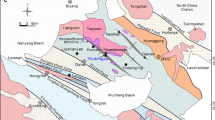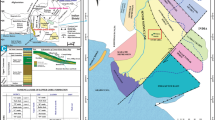Abstract
This study sheds a light on the depositional environment of the late Cretaceous phosphorite deposits that belong to Amman/Al Hisa Formation. The genesis of phosphorus supplied to the oceanic reservoir is still controversial, either it came through weathering of pre-existing rocks or through upwelling of deep cold water bodies. For a better understanding of the depositional environment, samples of two sections from the Amman/Al Hisa Formation were collected for petrographic, isotope, and geochemical analyses. Petrographic studies were conducted in order to determine the microfacies associated with their depositional environment. Representative samples of the phosphate rocks were analyzed to identify their mineralogical and chemical compositions based on XRF, XRD, phosphate, and carbonate contents. 42Ca/42Ca and 143Nd/144Nd isotopes also used as an indicator for the intensity of phosphogenesis and describe the long-term changes in ocean circulation and continental weathering. The three obtained standard microfacies (SMF) types were fallen under three facies associations: deep rim (mudstone), open-marine (pack-wackestone), and restricted basin (peloidal grainstone). A good correlation has been observed between phosphorus and calcium contents in three intervals throughout the studied sections. There is a positive correlation between SiO2, and Al2O3 aligned with high positive excursion of Ca isotope and negative excursion of Nd isotopes confirming the sources of the terrigenous input in the marine system. In this case, tectonism was considered as important factor in genesis of phosphate. Tectonism was shaping the sub-basins and thus phosphate deposited in silled basins or open-marine interior in Jordan. On the other hand, the availability of nutrient (P2O5) occurred in deep and open-marine basins and coinciding with negative relationship of SiO2, and Al2O3 has indicated the upwelling system. Deep cold current brought nutrient (P2O5) to the shallower areas. Therefore, switching into Neo-Tethys deep oceanic current pulses took place in the rule of phosphorite deposition receiving an enormous amount of nutrients during late Cretaceous time.













Similar content being viewed by others
References
Abed A (2013) The eastern Mediterranean phosphorite giants: an interplay between tectonics and upwelling. GeoArabia 18(2):67–94
Ali Hussein M, Alqudah M, Blessenohl M, Podlaha O, Mutterlose J (2015) Depositional environment of Late Cretaceous to Eocene organic rich marls from Jordan. GeoArabia 20(1):191–200
Alqudah M, Ali Hussein M, Podlaha O, van den Boorn S, Mutterlose J (2015) Biostratigraphy and depositional setting of Maastrichtian – Eocene oil shales from Jordan. Mar Pet Geol 60:87–104
AL-Shereideh S, Al-Taani A, EL-Radaideh N, Al-Tamimi M, Nazzal J (2010) Petrogenesis and origin of the phosphate beds in the upper Cretaceous Amman Silicified Limestone Formation, North-west Jordan. Palaontologie, Stratigraphie, Fazies (18), Freiberger Forschungshefte, C 536:183–193 (Freiberg)
Al-Tamimi M, Alqudah M, Al-Atawneh M, Nazzal J, AlShraideh S (2021) Depositional environment of Eocene oil shales of Wadi Shallala Formation from northern Jordan. Arab J Geosci 14:209
Andrews IJ (1992) Cretaceous and Paleogene lithostratigraphy in the subsurface of Jordan. Subsurface Geology Bulletin 5, Natural Resources Authority, Amman :60
Baturin GN (1981) Phosphorites on the sea floor: origin, composition and distribution. Elsevier, New York, pp 24–50
Bremner JM (1996) Nitrogen total. In: Bartels JM (ed) Methods of soil analysis, Part3: chemical methods. Wisc: SSSA, Madison, pp 1085–1121
Chen X, Sun X, Wu Z, Wang Y, Lin X, Chen H (2021) Mineralogy and geochemistry of deep-sea sediments from the ultraslow-spreading Southwest Indian Ridge: implications for hydrothermal input and igneous host rock. Minerals 11:138. https://doi.org/10.3390/min11020138
Dar AS, Khan FK (2016) Depositional environment of phosphorites of the Sonrai Basin, Lalitpur District, Uttar Pradesh, India.Open access peer https://doi.org/10.5772/62186.
Dhannoun H, Al-Dlemi A (2011) The relation between Li, V, P2O5, and Al2O3 contents in marls and mudstones as indicators of environment of deposition. Arab J Geosci, 6. https://doi.org/10.1007/s12517-011-0399-z
Dunham RJ (1962) Classification of carbonate rocks according to depositional texture. AAPG 1:108–121
Flügel E (2010) Microfacies of carbonate rocks: analysis, interpretation and application, 2nd edn. Springer-Verlag, Berlin
Folk RL (1962) Spectral subdivision of limestone types. In: Ham WE (ed) Classification of carbonate rocks. Mem Am Ass Petrol Geol Tulsa I:62–84
Glenn C (1990) Pore water, petrologic and stable carbon isotopic data bearing on the origin of Modern Peru margin phosphorites and associated authigenic phases. In: Burnett WC, Riggs SR (eds.) Phosphate deposits of the world: Neogene to Modern Phosphorites, 4th edn. Cambridge University Press, 3:46–61
Klaebe R, Kennedy M, Jarrett A, Brocks J (2016). Local paleoenvironmental controls on the carbon-isotope record defining the Bitter Springs Anomaly. Geobiology, 15. https://doi.org/10.1111/gbi.12217
Li M, Lei Y, Feng L, Wang Z, Belshaw N, Hu Z, Liu Y, Zhou L, Chen H, Chai X (2018) High-precision Ca isotopic measurement using a large geometry high resolution MC-ICP-MS with dummy bucket. J Anal At Spectrom, 33. https://doi.org/10.1039/C8JA00234G
Middleton V, Gerald C (2003) Encyclopedia of earth sciences series. Encyclopedia of sediment and sedimentary rocks. Kluwer Academic Publishers, Dordrect, Boston, London, p 131 (727, 519–524)
Moh’d B (1997) Geological sheet of Irbid, Map. Natural Resources Authority., Amman
Powell J, Moh’d BK (2011) Evolution of Cretaceous to Eocene alluvial and carbonate platform sequences in central and south Jordan. GeoArabia 16(4):29–82
Santana RC, Farnese A, Fortes M, Ataíde C (2008) Barrozo M (2008) Influence of particle size and reagent dosage on the performance of apatite flotation. Sep Purif Technol 64(1):8–15
Santos M, Santana R, Capponi F, Ataíde C, Barrozo M (2010) Effect of ionic species on the performance of apatite flotation. Sep Purif Technol 76:15–20. https://doi.org/10.1016/j.seppur.2010.09.014
Şenlikci A, Doğu M, Eren E, Çetinkaya E, Karadağ S (2015) Pressure calcimeter as a simple method for measuring the CaCO3 content of soil and comparison with Scheibler calcimeter. Soil-Water J 1:24–28
Shinaq R, Shereideh S, Saifludin N (2006) Microfacies and depositional environment of Upper Cretaceous phosphorites in northen Jordan. Palaontologie, Stratigraphie, Fazies (14), Freiberger Forschungshefte C 511:45–58
Soudry D, Glenn CR, Nathan Y, Segal I, VonderHaar D (2006) Evolution of Tethyan phosphogenesis along the northern edges of the Arabian-African shield during the Cretaceous-Eocene as deduced from temporal variations of Ca and Nd isotopes and rates of P accumulation. Earth Sci Rev 78:27–57
Tachikawa K, Rapuc W, Dubois-Dauphin Q, Guihou A, Skonieczny C (2020) Reconstruction of ocean circulation based on neodymium isotopic composition: potential limitations and application to the Mid-Pleistocene transition. Oceanography, 33. https://doi.org/10.5670/oceanog.2020.205
Tarawneh K, Altiti A, Alrawashdeh R (2019) Peak phosphate in Jordan. Int J Min Miner Eng 10:27. https://doi.org/10.1504/IJMME.2019.10019694
Wilson EO (1975) Sociobiology: the new synthesis. Belknap Press of Harvard University Press, Cambridge, MA, p 720
Zafar Z, Anwar MM, Pritchard DW (1995) Optimization of thermal beneficiation of a low-grade dolomitic phosphate rock. Int J Miner Process 43(1–2):123–131
Funding
This research is financially supported by the World Federation of Scientists. This research is funded by the Ministry of Higher Education (Fund Number BAS/1/2/2019) and Dean of Research and Higher Education/Yarmouk University (Fund Number 11/2020).
Author information
Authors and Affiliations
Corresponding author
Ethics declarations
Conflict of interest
The authors declare no competing interests.
Additional information
Responsible Editor: Attila Ciner
Supplementary Information
Below is the link to the electronic supplementary material.
Supplementary file1
(PDF 218 KB)
Supplementary file 2
(XLSX 12.5 KB)
Supplementary file 3
(ZIP 1.49 MB)
Supplementary file 4
( PDF 3.38 MB)
Rights and permissions
About this article
Cite this article
Alnimrat, R.M., Alqudah, M., Al-Shereideh, S. et al. Geochemical and petrological analyses of the phosphorite deposits (Amman/Al Hisa Formation) from northwest Jordan, and their insights for paleoenvironment. Arab J Geosci 15, 1259 (2022). https://doi.org/10.1007/s12517-022-10516-5
Received:
Accepted:
Published:
DOI: https://doi.org/10.1007/s12517-022-10516-5




